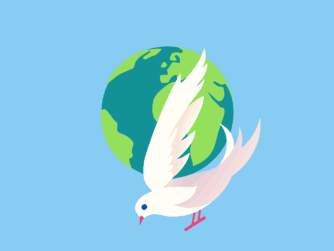Voice 1
Welcome to Spotlight. I’m Megan Nollet.
Voice 2
And I’m Patrick Woodward. Spotlight uses a special English method of broadcasting. It is easier for people to understand, no matter where in the world they live.
Click here to follow along with this program on YouTube.
Voice 1
This is the sound of a tuk-tuk, or auto-rickshaw. These small, brightly-colored vehicles have only three wheels. Some Tuk-tuks have no windows. Their engines are not very powerful. But the humble tuk-tuk has a broad appeal. For millions of people, the auto-rickshaw is the most important form of transportation that they have.
Voice 2
Today’s Spotlight is all about the tuk-tuk. We look at how these vehicles have helped countries improve their economies. We examine the important role tuk-tuks play in transportation. Together, we will explore the huge power of the small tuk-tuk.
Voice 1
Before the auto-rickshaw, there was the rickshaw. These human-powered carts usually had two wheels. A person would sit in a seat at the back while another pulled the cart behind them. A strong rickshaw driver could pull two or three people. But pulling a rickshaw is hard on the body. Rickshaw drivers once worked seventeen to eighteen hours a day to survive. They ran tens of miles a day. Many countries have banned this kind of transportation because it is so bad for the driver.
Voice 2
Tuk-tuks were first invented in Japan as a less-expensive form of car during the nineteen thirties. But these quickly found business applications after World War Two. A tuk-tuk could carry four of five people, many more than a rickshaw. But they cost less than a car or truck. These vehicles used less fuel. They were easier to maintain. Most importantly, tuk-tuks were easier on driver’s bodies.
Voice 1
Tuk-tuks soon became popular all-over southeast Asia, especially in large cities like Bangkok. Cities like Bangkok have heavy traffic. It is difficult for big cars and trucks to move. Tuk-tuks are a perfect solution to this problem. These smaller vehicles can get into places others cannot. Tuk-tuks can turn more quickly and get out of dangerous situations where traffic signals are not clear. Cam Wears is a travel writer. He rode in a tuk-tuk while visiting India. He said:
Voice 3
“Most places where vehicles cross do not have lights. Traffic rarely stops. Street signs are just a guide.”
Voice 2
Tuk-tuks also have other advantages in large cities. These take up less space than bigger vehicles. It is easier to park and store them. Drivers do not have to pay as much for the space. It is so easy to repair an old tuk-tuk that someone good with an engine can do it on their own. As time went on, they became a cheap alternative for transport. Auto-rickshaws are less expensive for drivers and for those who ride.
Voice 1
Dr. Sujai Suneetha has lived in Hyderabad, India for over thirty years. He and his wife started a small hospital twenty years ago. Many of the Suneethas’ patients are poor. They do not own cars or motorcycles. They must walk to the hospital. But they cannot walk if it is too far. They can only afford a ride in a tuk-tuk or a bus. Dr. Suneetha says:
Voice 4
“Tuk-tuks are one of the cheapest and most helpful ways to travel in India. Some patients are tuk-tuk drivers themselves. They store their vehicles outside of the hospital when they come for treatment. I also take a tuk-tuk to the hospital each day!”
Voice 2
People visiting these cities also like to use tuk-tuks. Today, the bright-colored tuk-tuks of Bangkok are famous. Some people visiting the city prefer to use these vehicles instead of cars. A tuk-tuk driver must know the best way around the city. Sometimes drivers share the history of the city with travelers. Or they tell stories about experiences they have had in the city. They are friendly and welcoming. This adds to the enjoyment of the trip.
Voice 1
The tuk-tuk’s design also makes the ride more interesting. There are no doors. Travelers can see, hear, and smell everything around them. Many visitors wish to take at least one tuk-tuk ride before returning home. Their trip would not be complete without experiencing it. The tuk-tuk has become a symbol of South Asia’s culture.
Voice 2
Today, a person can find a tuk-tuk in almost any country they go to. They are popular in Egypt, Pakistan, China, South Africa, and Italy. In 2022, there were 92,000 tuk-tuks in Deli, India alone. Even the United States of America has some auto-rickshaws in its larger cities. Peter Meitzler is the creative director of the Manhattan Rickshaw Company, in New York City. His auto-rickshaws are built like electric bicycles. He told the Smithsonian Magazine:
Voice 5
“When technology met the rickshaw, everything changed. Modern tuk-tuks have liquid brakes. They have devices to stop harmful movement. They have complete lighting systems, seat belts, full weather coverings, steel frames, and lightly-made bodies.”
Voice 1
One issue that tuk-tuks have is the pollution that their engines create. Many auto-rickshaws are still quite old. The people who made them did not know about the harm that pollution could could cause. Some countries have had to ban certain tuk-tuks from their cities because of these problems. Others have begun replacing traditional tuk-tuks with electric ones. These new tuk-tuks are a little more expensive for drivers. But one day these more energy-efficient vehicles may become the future of transportation in many countries.
Voice 2
People in many nations depend on tuk-tuks every day. They make money with tuk-tuks. They ride in auto-rickshaws to work or to school. They discover history and culture on these vehicles. And they do it all while riding on three wheels.
Voice 1
Have you ever ridden in a tuk-tuk? Did you like, or dislike it? You can leave a comment on our website at www.spotlightenglish.com. You can also find us on YouTube, Facebook, Instagram, Bluesky, and X. You can also get our programs delivered directly to your Android or Apple device through our free official Spotlight English app.
Voice 2
The writer of this program was Pete Anderson. The producer was Dan Christmann. The voices you heard were from the United States and the United Kingdom. All quotes were adapted for this program and voiced by Spotlight. This program is called, ‘The Mighty Tuk-Tuk.
Voice 1
We hope you can join us again for the next Spotlight program. Goodbye.
Question:
Have you ever ridden in a tuk-tuk? Did you like, or dislike it?





I never ride on tuk tuk,But i like the tuk-tuk vehice .
Yes , I LIKE TO RIDE TUK-TUK BUT I THINK MANY OF TUK-TUK IN THE CITIES HAPPEN Problem .
I dont have had any experince riding a tuk tuk before
Hi I have ridden Tuk Tuk, I Like it,
I’m from sri lanaka we are calling “Threewheel.” Lot of tourist come to our country
they Select to tuk tuk Travel around the country, it’s so much fun.
Yes I ‘am ready
yes, l ride a tuk-tuk when l go with my mum to market and when l go to college and ride it very much it seems iteresting but at the same time dangerous sometimes made an accident.
I was riding tuk tuk almost everyday in my country, Sudan during my study period in university. It is called rickshaw there and it is one of essential transportation vehicle.
I like riding rickshaw because it faster, easier way most of the time and I can enjoy the air passing through it as it’s open from all sides. But it is very noisy and can’t carry more than 3 people.
I never try riding the tuk – tuk , but I think it’s a nice vehicle